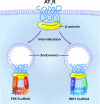G protein-coupled receptors as disease targets: emerging paradigms
- PMID: 21603346
- PMCID: PMC3096185
G protein-coupled receptors as disease targets: emerging paradigms
Keywords: GPCR; RIP (regulated intramembrane proteolysis); nuclear receptors; receptor cleavage.
Figures




Similar articles
-
Therapeutic Potential of Targeting Regulated Intramembrane Proteolysis Mechanisms of Voltage-Gated Ion Channel Subunits and Cell Adhesion Molecules.Pharmacol Rev. 2022 Oct;74(4):1028-1048. doi: 10.1124/pharmrev.121.000340. Pharmacol Rev. 2022. PMID: 36113879 Free PMC article. Review.
-
QARIP: a web server for quantitative proteomic analysis of regulated intramembrane proteolysis.Nucleic Acids Res. 2013 Jul;41(Web Server issue):W459-64. doi: 10.1093/nar/gkt436. Epub 2013 May 31. Nucleic Acids Res. 2013. PMID: 23729472 Free PMC article.
-
The Coxsackievirus and Adenovirus Receptor (CAR) undergoes ectodomain shedding and regulated intramembrane proteolysis (RIP).PLoS One. 2013 Aug 28;8(8):e73296. doi: 10.1371/journal.pone.0073296. eCollection 2013. PLoS One. 2013. PMID: 24015300 Free PMC article.
-
Got RIP? Presenilin-dependent intramembrane proteolysis in growth factor receptor signaling.Cytokine Growth Factor Rev. 2004 Oct;15(5):337-51. doi: 10.1016/j.cytogfr.2004.04.001. Cytokine Growth Factor Rev. 2004. PMID: 15450250 Review.
-
Ligand activation leads to regulated intramembrane proteolysis of fibroblast growth factor receptor 3.Mol Biol Cell. 2011 Oct;22(20):3861-73. doi: 10.1091/mbc.E11-01-0080. Epub 2011 Aug 24. Mol Biol Cell. 2011. PMID: 21865593 Free PMC article.
Cited by
-
Conformationally Restricted Monosaccharide-Cored Glycoside Amphiphiles: The Effect of Detergent Headgroup Variation on Membrane Protein Stability.ACS Chem Biol. 2019 Aug 16;14(8):1717-1726. doi: 10.1021/acschembio.9b00166. Epub 2019 Jul 29. ACS Chem Biol. 2019. PMID: 31305987 Free PMC article.
-
Cyclic Nucleotide-Directed Protein Kinases in Cardiovascular Inflammation and Growth.J Cardiovasc Dev Dis. 2018 Jan 23;5(1):6. doi: 10.3390/jcdd5010006. J Cardiovasc Dev Dis. 2018. PMID: 29367584 Free PMC article. Review.
-
Lessons from in vitro studies and a related intracellular angiotensin II transgenic mouse model.Am J Physiol Regul Integr Comp Physiol. 2012 Mar 1;302(5):R482-93. doi: 10.1152/ajpregu.00493.2011. Epub 2011 Dec 14. Am J Physiol Regul Integr Comp Physiol. 2012. PMID: 22170617 Free PMC article. Review.
-
Bringing GPCR Structural Biology to Medical Applications: Insights from Both V2 Vasopressin and Mu-Opioid Receptors.Membranes (Basel). 2023 Jun 16;13(6):606. doi: 10.3390/membranes13060606. Membranes (Basel). 2023. PMID: 37367810 Free PMC article. Review.
-
Disrupting GPCR Complexes with Smart Drug-like Peptides.Pharmaceutics. 2022 Jan 11;14(1):161. doi: 10.3390/pharmaceutics14010161. Pharmaceutics. 2022. PMID: 35057055 Free PMC article. Review.
References
-
- Allen R. A., Jesaitis A. J., Sklar L. A., Cochrane C. G., Painter R. G. Physicochemical properties of the N-formyl peptide receptor on human neutrophils. J Biol Chem. 1986;261((4)):1854–1857. - PubMed
-
- Cook J. L., Re R. N. Intracellular accumulation and nuclear trafficking of angiotensin II and the angiotensin II type I receptor. In: Frohlich E. D., Re R. N., editors. The Local Cardiac Renin Angiotensin-Aldosterone System. 2nd ed. New York: Springer; 2009. pp. 29–41.
-
- Carpenter G. Nuclear localization and possible functions of receptor tyrosine kinases. Curr Opin Cell Biol. 2003;15((2)):143–148. - PubMed
Grants and funding
LinkOut - more resources
Full Text Sources
Miscellaneous
